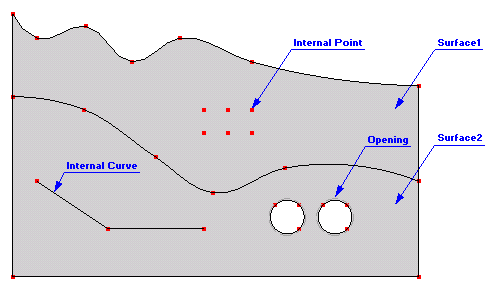The following commands are available in the Surfaces part of the Insert Menu:
Surfaces
Planar
Quadrangle
Rotary
Pipe
B-Spline
The term Surface in general refers to objects defining surfaces in 2D or 3D space. In Version 1 of HYDRUS, these surfaces had to be planar and were defined by their boundary curves. In Version 2 of HYDRUS, it was also be possible to use more general surfaces that could be curved in a 3D space (e.g, quadrangle, pipe, rotary, and B-Spline).
An object Surface refers to, depending on the problem type and the selection made in the Geometry Information dialog window, to:
AIn the 3D-Standard version, only available type of a Surface is a Planar Surface. Planar Surface is defined by its boundary curves that must all lie in the same plane and can not cross each other. In the 3D-Professional version, also the Curved Surfaces (Quadrangle, Rotary, Pipe, B-Spline) are available. While the boundary of a Planar Surface must be formed by multiple different Curves, the boundary of a Curved Surface can contain on one curve twice. An example is a Pipe Surface, in which the curve along a pipe occurs twice, each time with a different orientation. Note that the list of curves defining Pipe and Rotary Surfaces is generated automatically and cannot be edited, contrary to the list of curves defining Quadrangle or B-Spline, for which curves are selected by a user.
A Surface can contain various internal objects such as Openings, Internal Curves and Internal Points. These objects are described in detail at Internal Objects.
Figure below shows an example of a 2D domain defined using two Planar Surfaces:

Types of Surfaces: